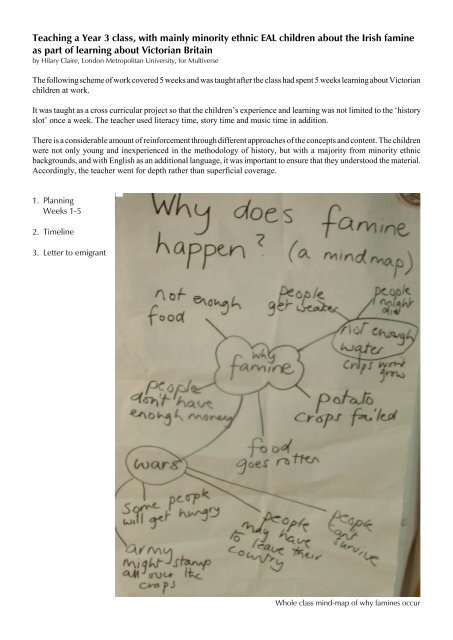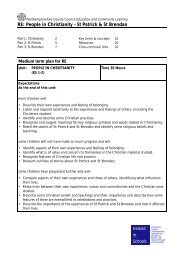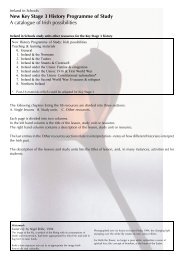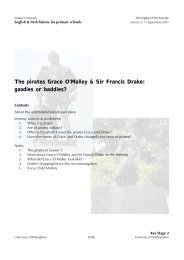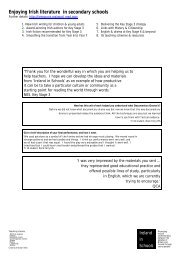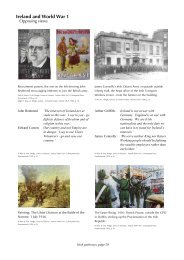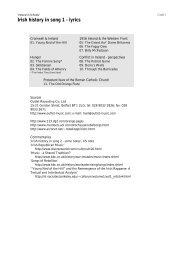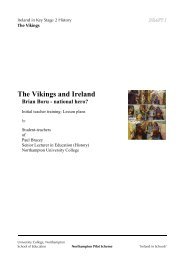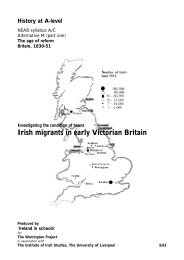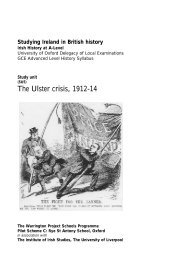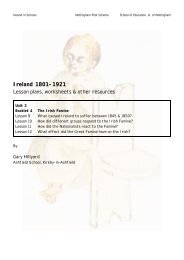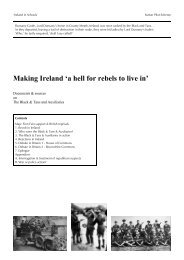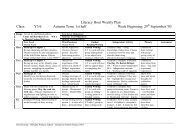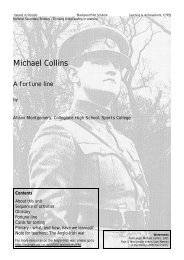Year 3 scheme of work - Ireland in Schools
Year 3 scheme of work - Ireland in Schools
Year 3 scheme of work - Ireland in Schools
- No tags were found...
Create successful ePaper yourself
Turn your PDF publications into a flip-book with our unique Google optimized e-Paper software.
Teach<strong>in</strong>g a <strong>Year</strong> 3 class, with ma<strong>in</strong>ly m<strong>in</strong>ority ethnic EAL children about the Irish fam<strong>in</strong>eas part <strong>of</strong> learn<strong>in</strong>g about Victorian Brita<strong>in</strong>by Hilary Claire, London Metropolitan University, for MultiverseThe follow<strong>in</strong>g <strong>scheme</strong> <strong>of</strong> <strong>work</strong> covered 5 weeks and was taught after the class had spent 5 weeks learn<strong>in</strong>g about Victorianchildren at <strong>work</strong>.It was taught as a cross curricular project so that the children’s experience and learn<strong>in</strong>g was not limited to the ‘historyslot’ once a week. The teacher used literacy time, story time and music time <strong>in</strong> addition.There is a considerable amount <strong>of</strong> re<strong>in</strong>forcement through different approaches <strong>of</strong> the concepts and content. The childrenwere not only young and <strong>in</strong>experienced <strong>in</strong> the methodology <strong>of</strong> history, but with a majority from m<strong>in</strong>ority ethnicbackgrounds, and with English as an additional language, it was important to ensure that they understood the material.Accord<strong>in</strong>gly, the teacher went for depth rather than superficial coverage.1. Plann<strong>in</strong>gWeeks 1-52. Timel<strong>in</strong>e3. Letter to emigrantWhole class m<strong>in</strong>d-map <strong>of</strong> why fam<strong>in</strong>es occur
Week 1Key questions and issues Organisation Resources & assessment opportunitiesWhere is <strong>Ireland</strong> ; where are the ma<strong>in</strong>areas we will learn about – the West;England, London, LiverpoolWhole classWorld mapMap <strong>of</strong> UKLarge map <strong>of</strong> <strong>Ireland</strong>(from <strong>Ireland</strong> <strong>in</strong><strong>Schools</strong> project)What does fam<strong>in</strong>e mean? Whole class Bra<strong>in</strong>storm - all ideas acceptedWhy does a fam<strong>in</strong>e happen? Teacher<strong>in</strong>troduces the potato blight as a causeWhy does a fam<strong>in</strong>e happen?Shar<strong>in</strong>g their <strong>work</strong> on causes <strong>of</strong> fam<strong>in</strong>eround the world: summarised andscribed on sugar paper, <strong>in</strong>clud<strong>in</strong>gdef<strong>in</strong>ition <strong>of</strong> fam<strong>in</strong>e produced by childrenRead<strong>in</strong>g first chapter <strong>of</strong> Marita Conlon-McKenna, Under the Hawthorn Tree,O’Brien Press, 0-86278-206-6*First ten m<strong>in</strong>utes <strong>of</strong> the video <strong>of</strong> Under theHawthorn Tree which more orless match<strong>in</strong>g the section read aloudLarge posters <strong>of</strong> fam<strong>in</strong>e abroad brought <strong>in</strong>and contemporary fam<strong>in</strong>esdiscussed <strong>in</strong> more detail (At the time,Northern Sudan is <strong>in</strong> the grips <strong>of</strong> asevere fam<strong>in</strong>e, which was on television.)Whole classGroups <strong>of</strong> 3 produc<strong>in</strong>gown spider diagramsWhole classWhole classWhole classBra<strong>in</strong>storm - all ideas accepted (see thechildren’s <strong>work</strong> below)Opportunity to see how much chrn hadunderstood & whether they <strong>in</strong>cluded thepotato blightOpportunity to check on def. <strong>of</strong> fam<strong>in</strong>eand re<strong>in</strong>force different causes, andspecific one for <strong>Ireland</strong>Questions about mean<strong>in</strong>gs <strong>of</strong> words &other difficultiesencountered <strong>in</strong> textChildren asked to start th<strong>in</strong>k<strong>in</strong>g <strong>of</strong>questions they want to askthe characters who might visit theclassroom later.Discussion- shar<strong>in</strong>g <strong>of</strong> knowledge andopportunity to ask questions* See also, Irene Barber, Under the Hawthorn Tree - The Great Irish Fam<strong>in</strong>e. A Study Guide to the Novel and the Film,O’Brien Press, O-86278-583-9Claire, Irish Fam<strong>in</strong>e with <strong>Year</strong> 3, page 2
Before the next session, teacher had made a book which covered the whole ‘story’ <strong>of</strong> the Fam<strong>in</strong>e from 1845 throughto 1850. This was entitled ‘The Great Hunger – The Irish Fam<strong>in</strong>e <strong>in</strong> the 1840s’.* It was illustrated with primarypictorial evidence found on the web, which was also enlarged, backed and lam<strong>in</strong>ated. All the pictorial material <strong>in</strong> thebook would also be used for children to use for historical enquiry and <strong>in</strong>terpretation. The backed pictures also wentlater onto a large class time l<strong>in</strong>e, along with the children’s annotationsWeek 2Key questions and issues Organisation Resources & assessmentopportunitiesTeacher shows and reads thebook about the Fam<strong>in</strong>eExplanation <strong>of</strong> why somepeople talked about th ‘GreatHunger’, and others the‘Fam<strong>in</strong>e’What does our primaryevidence tell us?Revision <strong>of</strong> idea thathistorians are ‘detectives’ whouse clues to f<strong>in</strong>d out whathappened.Mak<strong>in</strong>g a human time l<strong>in</strong>eChildren become morefamiliar with pictorialevidence and chronology <strong>of</strong>the Fam<strong>in</strong>e Consolidat<strong>in</strong>g idea<strong>of</strong> chronology and time l<strong>in</strong>esLearn<strong>in</strong>g two Irish songsLearn<strong>in</strong>g about and us<strong>in</strong>gdifferent <strong>in</strong>terpretations– this time through musicOpportunity to <strong>in</strong>volve EALpupils activelyClass on carpet. Questions about vocabulary andmean<strong>in</strong>g throughout.Discussed ‘primary evidence’ and ‘be<strong>in</strong>ghistorians’ with the children.Work<strong>in</strong>g <strong>in</strong> pairs, with one piece <strong>of</strong> pictorialevidence between them and large pieces <strong>of</strong> sugarpaper divided <strong>in</strong> 3, children used post-its to write‘what I can see and know’, ‘what I th<strong>in</strong>k – myop<strong>in</strong>ion’, ‘what I would like to knowEach child or pair has a picture or a captionwhich replicates the text andpictures <strong>in</strong> the book they had <strong>work</strong>ed with earlier,and the pictures they had used for <strong>in</strong>terpretation<strong>of</strong> evidence.Revis<strong>in</strong>g the order ‘Before, dur<strong>in</strong>g and after thefam<strong>in</strong>e’ teacher manages groups to stand andjo<strong>in</strong> the time l<strong>in</strong>e <strong>in</strong> the right order. Then they gothrough the story they have created <strong>in</strong> a‘human time l<strong>in</strong>e’Children on carpet: Words <strong>of</strong> both songs pr<strong>in</strong>tedout large and put on small board. Teacher sangthe verses – children learned the choruses andjo<strong>in</strong>ed <strong>in</strong> ‘Athenrye’ – expla<strong>in</strong>ed that this was asong about Michael who stole corn to feed hischild dur<strong>in</strong>g the Fam<strong>in</strong>e ‘Molly Malone’ – notfrom the fam<strong>in</strong>e times, but still Irish!Ready made (hand made)book tell<strong>in</strong>g story <strong>of</strong> theFam<strong>in</strong>e <strong>in</strong> pictures andcaptions^Opportunity to provideoverview knowledge andunderstand<strong>in</strong>g.Opportunity to assess howfar children could<strong>in</strong>terrogate and <strong>in</strong>terpret theevidence and what theirunderstand<strong>in</strong>gs wereReady made captions,pictures used for previousactivityOpportunity to re<strong>in</strong>forcechronology and help withvocabularyDur<strong>in</strong>g this week teacher prepared sheets <strong>of</strong> paper which would be blue tacked to the white board <strong>in</strong> random order.These were used <strong>in</strong> Week 3 for children to consolidate their understand<strong>in</strong>g <strong>of</strong> the chronology.* Possible published alternative <strong>in</strong>cludeMcKeown, Arthur, The Great Hunger, Frankl<strong>in</strong> Watts, 0-74963-447-2; andWilson, L., How I Survived the Irish Fam<strong>in</strong>e. The [Fictional] Diary <strong>of</strong> Mary O’Flynn, Gill & Macmillan, 0-71713-150-5.^ See pages 6-8 for captions/timel<strong>in</strong>e labels. The illustrations are <strong>in</strong> Appendix 4 <strong>of</strong> <strong>in</strong> the appendices to Hilary Claire’sMultiverse <strong>scheme</strong> at http://www.multiverse.ac.uk/attachments/2b9e0b77-137f-434c-be3e-cffd3e951d59.pdf.Claire, Irish Fam<strong>in</strong>e with <strong>Year</strong> 3, page 3
Week 3Key questions and issues Organisation Resources & assessmentopportunitiesWhat is the chronology <strong>of</strong> theFam<strong>in</strong>e?Extract from video: 1 st tenm<strong>in</strong>utes <strong>of</strong> Under the HawthornTree. The Great Irish Fam<strong>in</strong>e,Channel 4,/O’Brien Press, O-86215-496-1*Another <strong>in</strong>terpretation <strong>of</strong> thesame material, re<strong>in</strong>forcesread<strong>in</strong>g from thebook, provides vocabulary,visual detail to‘fix’ period and ideasWhat do we want to know?Revise the songsChrn <strong>in</strong> groups <strong>of</strong> 2 and 3: each with largepiece <strong>of</strong> sugar paper and sufficient strips <strong>of</strong>ready –cut paper for several events andpictures.‘Events’ randomly scattered on the whiteboardChildren choose at least 3 events, set <strong>in</strong>correct order, and draw anaccompany<strong>in</strong>g picture to illustrate. Primarypictorial evidence available tohelp with realistic detailChildren watch video <strong>in</strong>structed to considerwhat they would like to ask Margaret – themother <strong>in</strong> the video and story.Teacher goes through possible questions onsugar paper and saves for next session later<strong>in</strong> week (uses literacy time)Opportunity for children tore<strong>in</strong>forced vocabulary andchronology – showthey have understand; usesame evidence aga<strong>in</strong>, and<strong>in</strong>terpret <strong>in</strong> own wayVideoWeek 4Key questions and issues Organisation Resources & assessmentopportunitiesHot seat<strong>in</strong>g ‘Margaret O’ Brien’who visits the classOpportunity for <strong>in</strong>teractive oral<strong>work</strong>, and for teacher to feed <strong>in</strong>considerably more detail aboutthe Fam<strong>in</strong>e <strong>in</strong> response tochildren’s questionsFreeze frame <strong>work</strong> from thepictorial evidenceInterpretation through dramaF<strong>in</strong>ish with performance <strong>of</strong> thesongs – <strong>in</strong>vite the head teacher.Children have prepared questions dur<strong>in</strong>gliteracy time, us<strong>in</strong>g notes saved fromprevious week.Children <strong>in</strong> groups <strong>of</strong> 3 <strong>work</strong><strong>in</strong>g with apicture to develop 3 frames – before theirpicture, the picture itself, and what happensnext.Opportunity to gauge depth<strong>of</strong> understand<strong>in</strong>g throughnature <strong>of</strong> questions andrelevanceOpportunity for children withEAL or more difficulty withwritten <strong>work</strong> to<strong>in</strong>terpret material, <strong>work</strong><strong>in</strong>gcollaboratively* See also, Irene Barber, Under the Hawthorn Tree - The Great Irish Fam<strong>in</strong>e. A Study Guide to the Novel and the Film,O’Brien Press, O-86278-583-9Claire, Irish Fam<strong>in</strong>e with <strong>Year</strong> 3, page 4
Week 5Key questions and issues Organisation Resources & assessmentopportunitiesWhy do people leave theircountries? Introduce vocabulary– emigrate andimmigrateRem<strong>in</strong>der that we have foundthat nearly a million Irishimmigrated dur<strong>in</strong>g the Fam<strong>in</strong>e.Look at world map – where Irishwent (and later) where their ownparentscome fromIdentity <strong>work</strong> – who are we andwhere are we from?Mrs A visits – a refugee fromEthiopia dur<strong>in</strong>g the Civil Warcomes to talkto the class- why she left; whathappened to her when she cameto England; h ow she tries tokeep Ethiopian culture aliveF<strong>in</strong>ally, children s<strong>in</strong>g Mrs A thesongs they have learned from<strong>Ireland</strong>.Discussion with whole class on carpet, us<strong>in</strong>gsugar paper for notes about why peoplemight leave their countries.Many children (and their teachers) are first orsecond generation immigrants and they knowabout their identities and where their parentscame from Discussion <strong>of</strong> economicand political reasons for emigration (many <strong>of</strong>the children are refugees and others families’came for economic reasons).Each child has gone home and asked for more<strong>in</strong>formation about their identity, roots andwhy parents have moved. Children write anddraw <strong>in</strong>dividual biographies us<strong>in</strong>g literacytimeMrs A is parent <strong>of</strong> a child <strong>in</strong> the class and sheknows several children. Children on carpet.Listen and ask questions.Mrs A <strong>in</strong>teracts – ask<strong>in</strong>g them what otherlanguages they speak, and addresses one ortwo <strong>in</strong> their own languages.Opportunity to br<strong>in</strong>g therelevance <strong>of</strong> the historicalmaterial <strong>in</strong>to thechildren’s own lives and drawon their own experiencesOpportunity to assess how farchildren have understoodconcepts <strong>of</strong> migration.Claire, Irish Fam<strong>in</strong>e with <strong>Year</strong> 3, page 5
Time l<strong>in</strong>e <strong>of</strong> the fam<strong>in</strong>e years with captionsThese were used with Yr 3 children and a selection can be given to students for the human time l<strong>in</strong>e. The captions,along with the pictorial evidence, can be made <strong>in</strong>to a book for the children to read and keep <strong>in</strong> their class. (NB -pictures to illustrate all the captions are available on l<strong>in</strong>e, but but it would be enough to give the captions to studentsfor the purposes <strong>of</strong> this activity.)BEFORE THE FAMINEMost <strong>of</strong> the poorer people lived on potatoes, specially <strong>in</strong> the West <strong>of</strong> <strong>Ireland</strong>.Potatoes were easy to grow, good for us, and cheap if we needed to buy them.BEFORE THE FAMINEWe grew lots <strong>of</strong> potatoes and had enough to feed our families and to store some for the w<strong>in</strong>ter.BEFORE THE FAMINEWe even had enough potatoes to sell at the market.BEFORE THE FAMINEMost <strong>of</strong> us lived on someone else’s land. We were the tenants and we had to pay rent to the landlord. Wealso had to <strong>work</strong> for the landlord. We grew potatoes for ourselves, but we grew corn for the landlord.BEFORE THE FAMINEWe fed our pigs on potato peel<strong>in</strong>gs and had pork sometimes, or took the pig to market.BEFORE THE FAMINEWe collected seaweed to spread on the land and help the potatoes to grow well.IN 1841, BEFORE THE FAMINEThere were more than eight and a half million people liv<strong>in</strong>g <strong>in</strong> <strong>Ireland</strong>.BEFORE THE FAMINEThere were about 2 million people who didn’t have any land and travelled around look<strong>in</strong>g for <strong>work</strong> onother people’s farms.DURING THE FAMINEAbout one million Irish people died.DURING THE FAMINE AND IN THE YEARS AFTERWARDSAbout one and a half million had emigrated to other countries – America, Australia, Canada and England.IN 1845 DURING THE FAMINEA terrible th<strong>in</strong>g happened. Our potatoes got the blight and most rotted <strong>in</strong> the fields. We had very littleto eat, not enough to save for the w<strong>in</strong>ter, and almost noth<strong>in</strong>g to plant the next year.Claire, Irish Fam<strong>in</strong>e with <strong>Year</strong> 3, page 6
IN 1846 DURING THE FAMINEThe potato crop failed aga<strong>in</strong>. The corn grew but our landlords sold it. Or it was too expensive for us tobuy.DURING THE FAMINEThere were quite a lot <strong>of</strong> other crops and animals, but the landlords sold them to England so therewasn’t anyth<strong>in</strong>g for us to eat.IN 1846 DURING THE FAMINEA Christian group called the Quakers set up a FAMINE RELIEF COMMITTEE. They gave people food,and clothes and bedd<strong>in</strong>g.IN 1846The Quaker Fam<strong>in</strong>e Relief Committee set up SOUP KITCHENS to try and help the starv<strong>in</strong>g people.IN 1847 DURING THE FAMINEThe potato crop failed for the third time. People <strong>in</strong> other countries sent money to help.People <strong>in</strong> India, America, the Caribbean, France and even a Native American tribe sent money.IN 1848The potato crop failed for the fourth time.IN 1849There was another year when the potato crop failed. Now many people were quite desperate.ALL THROUGH THE FAMINE YEARS FOOD WAS BEING EXPORTEDThere was more food be<strong>in</strong>g exported (sent out for sale) than was com<strong>in</strong>g <strong>in</strong>, even though people <strong>in</strong><strong>Ireland</strong> were starv<strong>in</strong>g to death. The food be<strong>in</strong>g exported was guarded by soldiers, because the peoplewere so angry and sohungry.IN EARLY 1846 - EVICTIONS STARTEDIrish people who couldn’t afford to pay the rent were EVICTED by the landlords. Then their houseswere knocked down so the people couldn’t move back <strong>in</strong>.DURING THE FAMINE YEARSPeople took the roads with their children, begg<strong>in</strong>g for help and for food.DURING THE FAMINE YEARS - SOUP KITCHENSPeople were given a ration ticket for food. Children got ½ ration and grown ups got one ration each.DURING THE FAMINE YEARS - EVICTIONSThe landlord would give the family a NOTICE TO QUIT. Then he would come with soldiers and theywould knock down the house.Claire, Irish Fam<strong>in</strong>e with <strong>Year</strong> 3, page 7
DURING THE FAMINE: IN DECEMBER 1848 - CHOLERAThe terrible disease, CHOLERA, started to spread through the <strong>work</strong>houses.The Prime M<strong>in</strong>ister <strong>of</strong> Brita<strong>in</strong> refused to help.DURING THE FAMINE YEARS - WORKHOUSESLots <strong>of</strong> people ended up with nowhere to go to, except the WORKHOUSES. These were places run by theGovernment to help very very poor people. But it was horrible <strong>in</strong> the <strong>work</strong>houses, and people would only gothere if they were desperate.DURING THE FAMINE YEARS - EMIGRATIONAbout two million people decided to leave <strong>Ireland</strong> and make a new life somewhere else. They went toAmerica, Canada, Australia and to England. Some landlords paid their tenants to emigrate.DURING THE FAMINE YEARS - EVICTIONThe soldiers used crowbars to destroy people’s homes, when they had evicted the family.DURING THE FAMINE - EMIGRATIONThe conditions on the ships tak<strong>in</strong>g people to other countries were <strong>of</strong>ten terrible. Many people hop<strong>in</strong>g fora new chance, died on the ships.DURING THE FAMINE YEARSThe British government was <strong>in</strong> charge <strong>of</strong> <strong>Ireland</strong>, but they did almost noth<strong>in</strong>g to help the starv<strong>in</strong>g Irishpeople.DURING THE FAMINE - EMIGRATIONIt was very crowded on the ships tak<strong>in</strong>g people to America or Canada. A whole family would sleep <strong>in</strong> onebunk. Lots <strong>of</strong> people got ill, but there were no doctors or nurses, or medic<strong>in</strong>es.In 1851, AFTER THE FAMINE HAD ENDEDThere were only six and a half million people left <strong>in</strong> <strong>Ireland</strong>.Claire, Irish Fam<strong>in</strong>e with <strong>Year</strong> 3, page 8
Transcript <strong>of</strong> a letter from Marthew Rob<strong>in</strong>son, Liskey, Co. Tyrone, <strong>Ireland</strong>, to JamesRob<strong>in</strong>son, c/o James Haslim, No. 31 Exchange Street, Boston, America, 2 April 1847Liskey, April 2nd, 1847Dear JamesI once more take up my pen to Inform you that I am still <strong>in</strong> Good health hop<strong>in</strong>g that these few i l neswill f<strong>in</strong>d you <strong>in</strong> the same[.] I wrote you a letter on the twentyfirst <strong>of</strong> March 1847 and for fear youwould not get it I now write aga[<strong>in</strong>] for If you could do any th<strong>in</strong>g to asist Joseph and me gett<strong>in</strong>g on thisspr<strong>in</strong>g I would like that you would do it as fast as possible and the more asistance you would give allthe better as I could afford to take the more <strong>of</strong> my plish<strong>in</strong><strong>in</strong>g [?] that is to say beds and such like andsend me word all the th<strong>in</strong>gs we would require to have with us as I was th<strong>in</strong>k<strong>in</strong>g <strong>of</strong> <strong>of</strong> sett<strong>in</strong>g a lodg<strong>in</strong>gsand wash<strong>in</strong>g[.] there wer seven pounds sterl<strong>in</strong>g left <strong>of</strong> the f<strong>in</strong>e <strong>of</strong> the land and I got two poundsfourteen shill<strong>in</strong>gs and your uncle Jack Rob<strong>in</strong>son got the rest[.] thank God James Dear I had my healthto suppo[rt] my self and If I was with you now I could tell you an old story about your neighbours andaqua<strong>in</strong>tences for it is not easy to now who is either friend or foe these times[.] the people whom youthought was your nearest and Dearest friends has turned out to be costley friends to you[.]Dear James you wanted to hear <strong>in</strong> your last letter all the news about <strong>Ireland</strong>[.] there is news plentys<strong>in</strong>ce you left this but the worst news for <strong>Ireland</strong> is the failour <strong>of</strong> the potatoe crop[. ] I had better thana rood <strong>of</strong> potatoes set last year and I never got a shill<strong>in</strong>gsworth <strong>of</strong> meat out <strong>of</strong> them[.] the oat mealis 2”6d the peck and all small farmers has to leave their houses and they people are Dy<strong>in</strong>g <strong>in</strong> allquarters with hunger and starvation[.] Hary G<strong>in</strong> [?] is sold his place to the Bartons that was afterour[.] Jack McKnight has sold his place and is for America.[.] Br<strong>in</strong>e O Coll [?] and his daughter wentto New York at November last and Nedy Oneils son James went and has wrote home to the motherto sell our old place and to go to him[.] Aunt Nelleys two sons Peter and Francis Oneil is go<strong>in</strong>g outthis spr<strong>in</strong>g their sister Mary sent for them[.] saly smith <strong>of</strong> Clochigh sent for her two sisters she sentten pounds[.] David Smith <strong>of</strong> Clochigh sent ten pounds to his father he is Clerk <strong>in</strong> a store <strong>in</strong> New Yorkand 24 pound a year[.] James Robbs Daughters sent 5 pounds to take away the sister and Couz<strong>in</strong>[.]tilda fulton is no more there was two months between Matilda and her[.] Dear James I paid a greatdeal <strong>of</strong> Debt s<strong>in</strong>ce you went away a paid 8 pounds <strong>of</strong> D[ebt] s<strong>in</strong>ce I come to Mr K<strong>in</strong>gs and If I had notpaid it I […] been hear for every one leaped at me because I was wi[th] Mr K<strong>in</strong>g} send word If theCountry would fit any <strong>of</strong> Your uncle Jacks Mr Grays Daughters as I would wish to h[ave] one <strong>of</strong> themwith me for company[.] let me now if Jo[…] Jackson give you the two shirts and two pairs <strong>of</strong> socks Isent with him and let me nowhow you are for shirts socks and all you would stand <strong>in</strong> need <strong>of</strong> as I wou[ld] take them with me ifpossible[.] When you send the m[oney?] you can send it <strong>in</strong> the same way you sent the last for I h[ad]Claire, Irish Fam<strong>in</strong>e with <strong>Year</strong> 3, page 9
no trouble <strong>in</strong> gett<strong>in</strong>g it[.] I took <strong>in</strong> Thomas Mr Gowan to the Prov<strong>in</strong>cial Bank <strong>in</strong> Omagh and we gotit at on[ce.] Widow Russell is <strong>in</strong> good health and she wishes to now if […] Jackson got the letter thatshe sent and she would go to a[merica?] if they would give her any encouragement for <strong>Ireland</strong> isdo[ne.] Mary Jacksons family is beg<strong>in</strong>g and the last letter they got when I went to hear it Read the partthat began to speak about J cut so I Droped them from that forward[.] they got three poun[ds] firstand then they got four secondly[.] Dear James I wou[ld] not like to part with the watch to I would giveit to your s[elf] and Dear James I long to get out <strong>of</strong> this country from among these poor people forstarvation is pictured almost <strong>in</strong> all countenances[.] no more at present but rema<strong>in</strong>s your affecionetMother to DeathMarthew Rob<strong>in</strong>sonDear James be m<strong>in</strong>dfull <strong>of</strong> your duty to God and Keep from among bad companyWrite as soon as this comes to handWrite <strong>in</strong> HaistClaire, Irish Fam<strong>in</strong>e with <strong>Year</strong> 3, page 10


